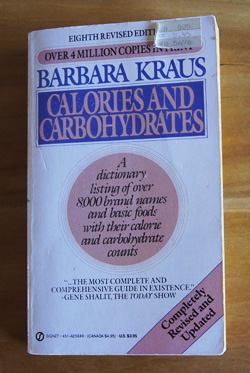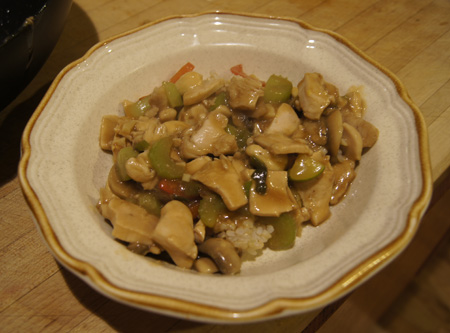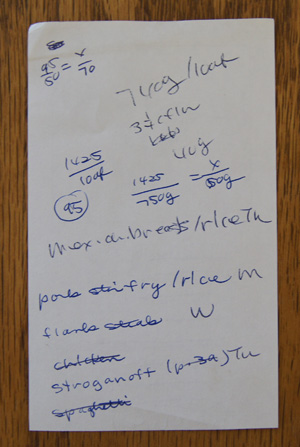Cookbook #98: Calories and Carbohydrates, Barbara Kraus, NAL Penguin Inc., NY, NY, Eighth Revised Edition, thirty-seventh Signet printing, 1989.
 This is not really a “cookbook”. It’s a calorie counter reference. But I had it entered in my 250 cookbooks database so I consider it a proper book to cover in this blog. My blog, my rules.
This is not really a “cookbook”. It’s a calorie counter reference. But I had it entered in my 250 cookbooks database so I consider it a proper book to cover in this blog. My blog, my rules.
I used to count and limit calories as a means to lose weight. This went on for decades. The height of my obsession with this dieting method were the years that I weighed the foods I ate, calculated the calories, entered the calories and my weight in a database, and graphed the results. I don’t do that anymore. But it was an important phase of my lifetime weight management, because I learned how to estimate calories in foods, and to pay close attention to portion size.
This book is a holdover from those days. I bought it for myself, brand new. Probably in a January . . . New Year’s resolution time.
Calories and Carbohydrates lists the calorie/carbohydrate contents of common (and uncommon) foods as well as brand-name packaged food items. For instance, let’s look at the entries for beef. Different cuts of beef are listed with the calories per ounce. A pound of raw flank steak has 653 calories; 4 ounces of braised flank steak has 222 calories. Armour frozen Dinner Classics Beef Stroganoff has 370 calories in an 11 1/4 ounce meal.
This book has so much information that it takes awhile to find what you want. Ice cream is listed by flavor and manufacturer. Wine is listed not by red or white, but by type, such as merlot or chardonnay. Oranges are listed by variety, such as Florida or California valencia or navel. So you have to remember which type you bought. Oh! Just above “oranges” I find that 4 ounces of roasted opossum has 251 calories and 0 carbohydrates. (There are some fun tidbits in this book.)
Note the publication date of my copy of Calories and Carbohydrates: 1989. At that point in time, food products were sold without a nutrition content label. Thus this book once provided a great service. Beginning May 8, 1994, food companies were required by law to begin using nutrient content labels on packaged foods, a label mandated for most food products under the provisions of the 1990 Nutrition Labeling and Education Act (NLEA), per the recommendations of the U.S. Food and Drug Administration. These package labels are a boon to the calorie counter.
The Internet was just beginning to bloom 1989. (I remember, I was there, with my first MacPlus and a dial-up modem.) Today, it is very easy to find calorie content online. My go-to site is Nutrient Facts. The nutrition fact labels for packaged products are often online. Most chain restaurants post the calories of their meals. For instance, from this site, you can download a pdf that lists the calories, fat calories, protein, and nutrition values for all menu items at McDonalds restaurants.
The latest edition of Calories and Carbohydrates appears to be 2005; perhaps because the need for this book was diminished by that time.
For this blog entry, I decide to cook one of my everyday meals and calculate the calorie total using two different sources: Kraus’ book and values I find on the Internet. Sounds like fun.
I choose to make a chicken-vegetable-cashew stir fry.
 I weighed each ingredient during preparation. I felt like a scientist again! Later I looked up the calories in both Calories and Carbohydrates and on the Internet. Here are my results:
I weighed each ingredient during preparation. I felt like a scientist again! Later I looked up the calories in both Calories and Carbohydrates and on the Internet. Here are my results:
| Kraus’ book | Internet source | |
| brown rice, 2/3 cup dry | not available | 453 |
| chicken breast, 10 oz. uncooked | 308 (8 oz. cooked) | 310 |
| soy sauce, 3 tablespoons | not available | 30 |
| vinegar, 1 tablespoon | 2 | 0 |
| celery, 2 1/2 ounces | 12 | 5 |
| green onion, 1/2 ounce | 5 | 5 |
| mushrooms, 2 3/4 ounces | 23 | 28 |
| red pepper, 3/4 ounce | 7 | 7 |
| cashews, raw, 1 ounce | 159 | 157 |
| cornstarch | 30 | 30 |
| vegetable oil | 120 | 124 |
Total calories, internet values, 1149. (Divided between two people, this is under 600 calories/person.)
Comments on calorie results
Time: I timed each search, book and Internet. It took me 10 minutes and 15 seconds to look the ingredients up in the book, and 6 minutes and 50 seconds to look them up online.
Ease of search: The book values for chicken are not exactly helpful. It lists the calorie count for a whole, bone-in chicken, or for cooked chicken (either baked or fried). The value for raw chicken is the one I needed, because It is impossible to weigh cooked chicken after it is in a sloppy stir fry. This was frustrating. The book lists calories for cooked white rice, but the only brown rice listing was a value for Uncle Ben’s brown rice parboiled with butter. Not helpful.
I tried Nutrient Facts first for the Internet search on each item. It is easy to find raw or cooked values for the chicken, and it is easy to change the measurements between different weight or volume values. The Nutrient Facts site did not have “cashews”, so I simply entered “cashew calories” into a google search and the result popped up immediately.
Conclusion: The internet is the fastest and easiest (not surprising!). Accuracy might be an issue but note the close agreement between the book and Internet values.
Even with the Internet, I would like to always have one printed book of calorie counts in my possession, but I will not keep Calories and Carbohydrates (I have other calorie-counter books on my shelves). Calories and Carbohydrates contains so many entries that searching is difficult, and values for meats are difficult to decipher. I will recycle this book.
Extra note
Below is a note of mine that I found in this book. I date this note to about 20 years ago.
 The calculations are for the calories in a loaf of “my daily bread” and specifically, that there are 95 calories in a 50 g slice.
The calculations are for the calories in a loaf of “my daily bread” and specifically, that there are 95 calories in a 50 g slice.
The scribbles under that are for meals that I planned for the week: Mexican chicken breasts over rice on Thursday, pork stir fry on Monday, flank steak on Wednesday, stroganoff on Tuesday. These could be the meals I would cook in a week to this day! I AM IN A RUT!
This sad state of affairs led me to find something new to cook on a weeknight. (Retirement has its pluses. Most of all: Time.) On the Cooks Illustrated website, I found Tuscan-Style Beef Stew and served it over Creamy Parmesan Polenta (Cooks Illustrated too). The sauce created by the slowly baked meat is wonderfully complex, with garlic, shallots, carrots, rosemary, bay leaves, cracked black pepper, tomato paste, anchovy paste, and a lot of red wine. After a long slow braise, the sauce is strained, more wine added, and reduced. Absolute yum factor. I’ve made the Creamy Parmesan Polenta before and it was a perfect base for the dark sauce and tender beef.
